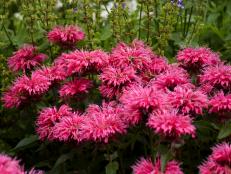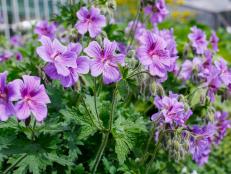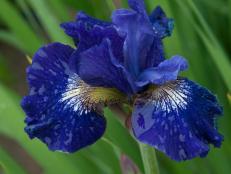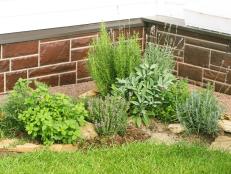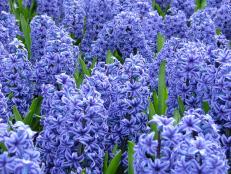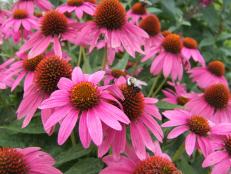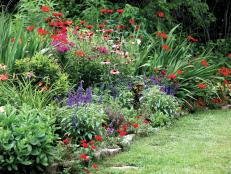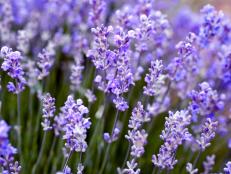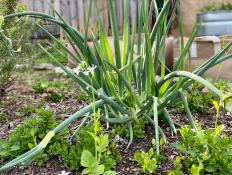How to Grow Yucca
Yucca indoor plants add style to your home, while outdoor yucca plants make striking garden accents. Give these adaptable, easy-to-grow beauties a try.

PerennialResource.com
At just 18 to 24 inches tall, with a compact, rounded shape, Yucca filamentosa ‘Excalibur’ is ideal for containers or small spaces.

Tough, drought-tolerant yucca plants (Yucca spp.) are evergreen shrubs, plants and trees with striking good looks. There are 40 or 50 species in the genus, which is native to southern North America. Use one of these low-maintenance perennials as an outdoor yucca plant or pot up a small or slow-growing variety and enjoy your yucca plant indoors.

ProvenWinners.com
Yucca 'Color Guard' grows to two feet tall and wide and is considered one of the most beautiful variegated yucca plants.
Note: Yuccas can be toxic to pets and grazing animals and some parts may be toxic to humans. Red yuccas are poisonous.
Growing Yucca Plants
Outdoor yucca plants thrive in arid conditions, full sun and sandy soils like those found in parts of Mexico and the southwestern United States. Some yuccas are hardy in Zones 5 to 11, while a few are hardy to Zone 4.
Foolproof Winter-Hardy Tropical Plants 10 Photos
These tropical beauties can thrive in areas as low as zone 6.
Yucca indoor plants, like their outdoor relatives, need little water and soil that drains easily. They also need bright, indirect light. Give them a south- or west-facing window and avoid direct sun that can burn their leaves.
Don't be disappointed if your yucca indoor plant doesn't bloom. Some need more light than they can get inside and others take years to mature and bear flowers. Others need special yucca moths around to pollinate them. Try encouraging your yucca to bloom by applying bone meal or a fertilizer with extra phosphorus.
Yucca Species, Varieties and Cultivars
Two yucca species are commonly grown as indoor plants.
- Yucca gigantea, also known as Y. elephantipes or Y. guatemalensis, is a popular indoor yucca plant. You may hear it called yucca cane plant or spineless yucca. Y. elephantipes forms a small, branching tree with a base that resembles an elephant's foot and rosettes of sword-like leaves. Used as a yucca tree indoors, it grows slowly to reach about 6 feet tall. Outdoors, it's hardy in Zones 9 to 11.
- Yucca aloifolia, also called aloe yucca, Spanish dagger or Spanish bayonet, is the second species commonly grown as an indoor yucca plant. Native to the Atlantic and Gulf coasts of the United States, it grows slowly enough to use as a houseplant for years, but beware of its stiff leaves with serrated edges and sharp tips. Under the right outdoor conditions, Y. aloifolia produces big panicles of fragrant, white flowers, but it rarely flowers indoors. It's hardy in Zones 8 to 11.
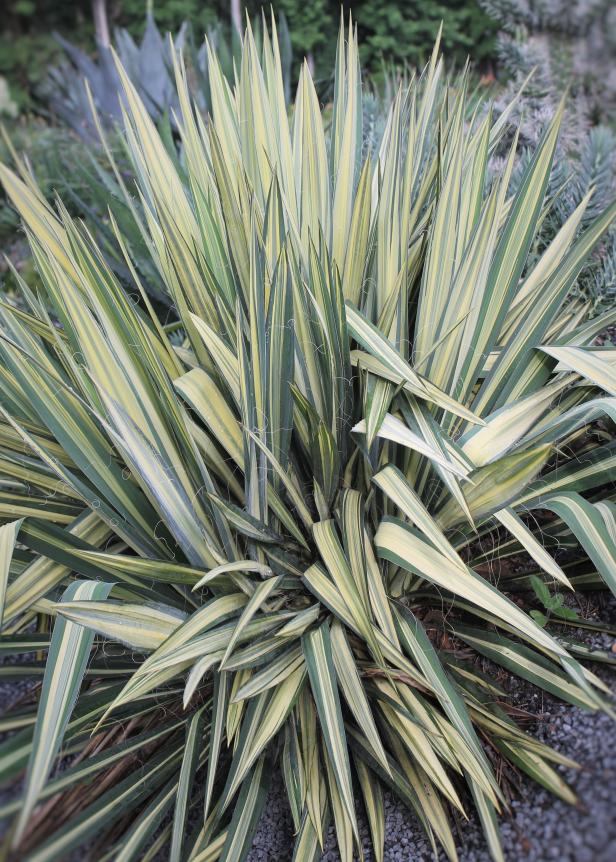
Plant Delights Nursery
Yucca flaccida 'Wilder's Wonderful' grows to 18 to 20 inches tall with yellow and cream striped leaves.
Y. filamentosa, Y. gloriosa, Y. brevifolia, Y. flaccida and Y. rostrata are other popular species. While they’re often grown outdoors, most grow slowly, so they can be used as yucca indoor plants for years.
- Yucca filamentosa 'Adam's Needle' — This handsome yucca has bluish-green leaves edged with curly white filaments, sometimes called threads or hairs. It's hardy in Zones 5 to 10.
- Y. gloriosa var. gloriosa 'Tiny Star' — This small selection is another good yucca indoor plant, reaching 10 to 18 inches tall. Hardy in Zones 7 to 10, it has a shrubby growth habit and creamy gold leaves marked with thin green bands.
- Y. brevifolia or Joshua tree — Long, narrow stiff leaves with sharp points are found on this yucca species, which is also called tree palm, yucca palm and palm tree yucca. It's seldom planted in home gardens because it needs desert or semi-desert conditions. According to the National Park Service, it grows one-half to three inches a year.
- Y. rostrata or Blue Beaked Yucca — This species forms rosettes of blue-green leaves with sharp tips. As it matures, it forms a short, sturdy trunk. Hardy in Zones 5 to 10, it's excellent for use in containers.
- Y. flaccida 'Color Guard' — This variegated yucca, sometimes shown as Y. filamentosa, grows 2 to 3 feet tall in containers and produces green and pale yellow leaves with sharp tips. It's hardy in Zones 4 to 10.
- Y. filamentosa 'Bright Edge' — Known for its stiff, sword-like leaves with bright gold edges, this dwarf cultivar is hardy in Zones 4 to 9. It makes a fine container plant.
- Y. flaccida 'Wilder's Wonderful' — Another variegated yucca, 'Wilder's Wonderful' grows 18 to 24 inches tall with green and creamy-white striped leaves.
- Hesperaloe parviflora, or red yucca, isn't a true yucca. This evergreen perennial has grass-like, bluish-green, arching leaves. When grown outdoors, it produces tall stalks of red or yellow flowers that attract hummingbirds. It's hardy in Zones 5 to 11. If you use it as an indoor plant, give red yucca a large container, bright light and plenty of sand in its potting mix.

Charming 'Tiny Star' yucca is sometimes called 'Tiny Star Soapwort'. Image courtesy of Plant Delights Nursery.
Caring for Yucca Plants
Soil
Use a succulent, cactus or other well-draining potting mix for indoor yucca plants. Make sure your container has drainage holes. The best soil for outdoor yucca plants is well-draining, sandy soil with a neutral to acidic pH.

Plant Delights Nursery
'Silver Anniversary' yucca plants have handsome, dusky-blue leaves. Outdoor-grown plants bear white flowers in the spring.
Water
Overwatering is a common problem with yucca plants, leading to root rot and yellow foliage. While these succulents are drought-tolerant, prolonged dry periods can damage their roots. Water indoor yucca plants when the top inch of the soil dries out. In the winter, water only enough to keep the leaves from shriveling. You can occasionally mist indoor yucca plants, but it's not necessary.
Fertilize
When they're actively growing, feed yucca plants once a month with a balanced liquid fertilizer or slow-release fertilizer. Follow the directions on the label for how much to apply.
Weed Outdoor Yuccas
Because some yuccas have razor-sharp leaves, spines or spiky tips, weed carefully around them. Plant them away from walks, driveways or other areas where visitors might brush against them.
Scout for Health Issues
Yucca plants are typically low-maintenance, but pests sometimes attack their leaves and suck their juices. Knock aphids and mealybugs off indoor yucca plants with a stream of water from your kitchen sink or shower. Use a garden hose on outdoor yucca plants. Repeat if the pests come back.
Neem oil will help get rid of scale, while insecticidal soaps control agave plant bugs, two-spotted mites (which are arachnids, not insects) and persistent mealybugs.
Yucca weevils are black beetles that tunnel into plant crowns. There's no treatment for them, so remove and destroy them as soon as you see them. Discourage them from returning to outdoor yucca plants by planting in a different location for several years.
Yuccas seldom have serious disease problems. Overhead watering can cause leaf spotting, so water at the base of the plants. Be sure your soil drains easily to avoid stem rot.
How to Propagate Yucca Plants
You can grow yucca plants from seeds, but they may take weeks to germinate. First, gently rub the seeds with sandpaper or a file to help open the coats. Some gardeners soak them overnight in water instead. Sow the seeds in a seed starter mix that drains easily. Keep them damp, not wet, and in a warm, sunny spot until they sprout. Don't be disappointed if they don't sprout. Not all seeds will be viable, and, depending on the variety or cultivar you’re growing, not all will produce plants that look like the parent.
It's easier to propagate outdoor yucca plants from sections. In the winter or spring, use a shovel to cut three-inch sections from the roots. Be sure to get some of the parent's roots with each section. Replant the sections in well-draining soil in indirect light. Growth should begin in a few weeks.
You can also use a sharp knife to cut offshoots, called pups, from parent yucca plants. Again, get some of the parent's roots with them. Remove only green pups and let whitish or pale green ones continue to mature. Plant the pups in well-draining soil and fertilize them.







